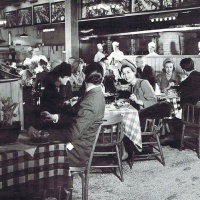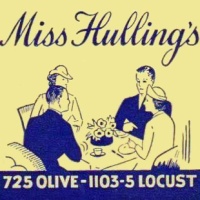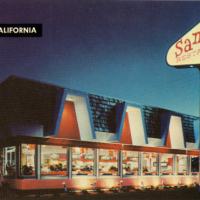 Despite an off-and-on economy, the 1980s was a decade in which Americans ate out more often than ever before. Gone were the days when people indulged in a nice restaurant dinner only when traveling or celebrating a birthday or anniversary. Now no reason was needed at all. Restaurants were for convenience, but also for entertainment, pleasure, new experiences, and sometimes only incidentally for nourishment.
Despite an off-and-on economy, the 1980s was a decade in which Americans ate out more often than ever before. Gone were the days when people indulged in a nice restaurant dinner only when traveling or celebrating a birthday or anniversary. Now no reason was needed at all. Restaurants were for convenience, but also for entertainment, pleasure, new experiences, and sometimes only incidentally for nourishment.
A food elite emerged, composed of frequent restaurant-goers with insatiable hunger for new cuisines and unfamiliar foods. Paralleling the growth of the food elite were chefs who became famous as they gave interviews, dashed off cookbooks, and demonstrated cooking techniques on the dais and the small screen. “Food is now the stuff of status,” said wine and restaurant critic Robert Finigan in 1983, comparing the public’s adoration of chefs to their awe of fine artists.
 A growing interest in healthier diets influenced restaurant menus, which began to feature less red meat and more pasta, fish, and chicken dishes. Concern with smoking and drunk driving brought changes too, as restaurants set aside non-smoking sections and saw their liability insurance premiums rise even as drink orders declined.
A growing interest in healthier diets influenced restaurant menus, which began to feature less red meat and more pasta, fish, and chicken dishes. Concern with smoking and drunk driving brought changes too, as restaurants set aside non-smoking sections and saw their liability insurance premiums rise even as drink orders declined.
The food fashion cycle quickened as diners discovered a taste for arugula, radicchio, goat cheese, sun-dried tomatoes, sushi, crab cakes, Pad Thai, mesquite grilling, and fresh ingredients. Meanwhile old favorites such as steak and baked potato, tossed salad, and cheesecake seemed dull.
 Though shunned by the food elite, corporate chain restaurants continued to grow and thrive. By the middle of the decade 540 chains managed 60,000 fast-food restaurants, employing over half of the nation’s restaurant workforce. Restaurant groups proliferated, ranging from those that owned a dozen or fewer restaurants in one city to groups controlling hundreds of franchises throughout a region. Independent restaurateurs, too, found it increasingly attractive to operate more than one restaurant.
Though shunned by the food elite, corporate chain restaurants continued to grow and thrive. By the middle of the decade 540 chains managed 60,000 fast-food restaurants, employing over half of the nation’s restaurant workforce. Restaurant groups proliferated, ranging from those that owned a dozen or fewer restaurants in one city to groups controlling hundreds of franchises throughout a region. Independent restaurateurs, too, found it increasingly attractive to operate more than one restaurant.
Traditional eating places, from the humblest to the grandest, suffered from intense competition. Losers included coffee shops, Cantonese Chinese and red-checkered Italian restaurants, and even sanctums of haute French cuisine.
Black men, who formed the basic waiter corps of the 19th century, largely disappeared from restaurant dining rooms and kitchens, replaced by immigrants, white college students, and white women. A 1981 study conducted in NYC found that Black workers rejected the low pay and poor conditions typically found in restaurant kitchens, preferring to take better jobs in industry if they could. Racial discrimination also kept them from waiting jobs in some instances and the limited number of Black-owned restaurants prevented widespread training in kitchen skills and entrepreneurship.
Though conditions were improving, women also faced continuing discrimination in restaurant work. Many luxury restaurants rejected them as waitstaff in the belief that patrons attributed higher status to male servers. Other objections were their alleged “boyfriend problems” and lack of “tableside” skills such as meat carving and salad making. An article in the trade journal Restaurant Hospitality noted that while more women had become bartenders, chefs, and managers by end of the decade, “For women, the American foodservice industry is still rife with barriers.” In the kitchen, women tended to be confined to pastry and pantry. Some women chefs said the solution was to open their own restaurants even though they might have to take on a male partner to get financing.
Highlights
1981 Social indicators – small families, working women, projected long-term increases in real income and leisure, and more single-person households — promise growth in restaurant going according to a Bank of America Small Business report.
 1982 Having introduced nouvelle cuisine at Ma Maison in Los Angeles, Chef Wolfgang Puck presents “California cuisine” to patrons of his new chic-casual Sunset Strip restaurant, Spago. Pizza with Duck Sausage wins quick stardom.
1982 Having introduced nouvelle cuisine at Ma Maison in Los Angeles, Chef Wolfgang Puck presents “California cuisine” to patrons of his new chic-casual Sunset Strip restaurant, Spago. Pizza with Duck Sausage wins quick stardom.
1983 The Food Marketing Institute reports that 2/3 of all fish consumed in the U.S. is eaten in restaurants. In Seattle, Colonial-themed  Mad Anthony’s executes a style and cuisine turnabout, replacing a beefy Steak & Kidney Pye-style menu with seafood. Onto the auction block go pewter plates, crocks, jugs, and replica muskets, along with a Nacho Cheese Dispenser.
Mad Anthony’s executes a style and cuisine turnabout, replacing a beefy Steak & Kidney Pye-style menu with seafood. Onto the auction block go pewter plates, crocks, jugs, and replica muskets, along with a Nacho Cheese Dispenser.
1984 With the opening of Spiaggia in Chicago, Chicagoans learn that Italian doesn’t inevitably mean spaghetti and candles in Chianti bottles, as they sample pumpkin-stuffed pasta and goose carpaccio with shaved white truffles. With dinner for two easily totaling $100 [about $228 now], they learn it often means higher prices too.
1985 Even as restaurant patrons in much of the country search out new restaurants and cuisines, Southerners remain loyal to cafeterias, with five major chains operating from 84 to 149 units each. In Milwaukee, taverns continue to do brisk business serving deep fried fish on Friday nights.
 1986 Most restaurant reviewers contributing to John Mariani’s Coast-to-Coast Dining Guide report that their towns have better restaurants and a wider selection of ethnic cuisines than ten years earlier. A number of cities lag behind, though, including Minneapolis and Chicago where many cling to meat and potatoes, and Columbus OH which has the dubious distinction of serving as a test market for fast food chains.
1986 Most restaurant reviewers contributing to John Mariani’s Coast-to-Coast Dining Guide report that their towns have better restaurants and a wider selection of ethnic cuisines than ten years earlier. A number of cities lag behind, though, including Minneapolis and Chicago where many cling to meat and potatoes, and Columbus OH which has the dubious distinction of serving as a test market for fast food chains.
1987 With new laws holding restaurants responsible for customers who cause drunk driving injuries, rising numbers of liability lawsuits against restaurants, and ballooning insurance premiums, American Express promises protection to restaurants that accept its charge card.
 1989 The “largest ever” bias lawsuit involving a restaurant chain is filed against the 1,500-unit Shoney’s and its head Ray Danner. The suit by the NAACP’s Legal Defense and Educational Fund charges that Shoney’s sets limits on how many Black workers can be hired in each outlet, keeps them in jobs out of public view, and punishes white supervisors who refuse to go along with the program.
1989 The “largest ever” bias lawsuit involving a restaurant chain is filed against the 1,500-unit Shoney’s and its head Ray Danner. The suit by the NAACP’s Legal Defense and Educational Fund charges that Shoney’s sets limits on how many Black workers can be hired in each outlet, keeps them in jobs out of public view, and punishes white supervisors who refuse to go along with the program.
© Jan Whitaker, 2017












 It's great to hear from readers and I take time to answer queries. I can't always find what you are looking for, but I do appreciate getting thank yous no matter what the outcome.
It's great to hear from readers and I take time to answer queries. I can't always find what you are looking for, but I do appreciate getting thank yous no matter what the outcome.



Pingback: Why Early-Bird Dining Is Sweeping the Country -
I’m trying to find a restaurant that was in Greenwich village nyc in mid 70s-80s. It may have been on waverly place and it is not the waverly diner. This restaurant was in the middle of the block. They had singing waiters and waitresses. I would like to know name of restaurant and possibly picture. Can you please help me. Thanks
Pingback: Can the 1980s Restaurants Be the Key to Growth in the 2020s? - Foodservice IP
Would you happen to know the name of the restaurant before it was considered has Charlie Pyatt owed it. This was in the 80s.
I’m confused about the wording of your question and also what restaurant you are referring to.
I left a comment on your blog, or tried. Anyway, enjoyed reading this.
sincerely, Meredith https://www.etsy.com/shop/MeredithBrittCollage?ref=hdr_shop_menu
This is the decade when I first went to the USA. We did a ‘house swap’ with a family from Santa Cruz in California. We were youngish professionals with two kids, so were they. I had read so much about California and was expecting great things when dining out. Once we got the little problem of babysitters sorted out, we were eager to try all the recommended restaurants within a reasonable radius.
The first thing that really struck us was how early everyone went out to eat. I don’t mean families, I mean couples. To be seated at a table by 6.30pm seemed to be the norm. As Europeans (albeit British) this seemed ridiculously early…8pm to 9pm was what we would have expected.
The next thing was that the waiters and waitresses practically sang us a litany of all the dishes on the menu, something that we were not used to at all. We would expect to peruse the menu and ask questions if and when we needed information, as we did in France or Italy. They ‘talked-up’ every dish, which in reality sometimes we found lacking. The portion sizes were enormous – huge – a family in Africa could have lived on one portion for a few days, the volume of wasted food must have been breathtaking back then. We were in awe of the quality of the meat, and how much of it Americans ate. T-bone steaks which were so, so, good – but served with a heart-attack inducing number of side dishes, many of them fried or in over rich sauces.
My dear husband who loves cheese and a glass of a good red wine at the end of a meal was in despair at the appalling selection of cheeses he was served in some really well-known restaurants. Fast forward 30 years, and all and so much has changed, the USA is producing some wonderful artisanal cheeses which are served in many restaurants. We visit San Francisco regularly and the food served at restaurants there is usually superb. It seems to me that American restaurant food has really come into its own.
Thanks for writing, so interesting. Things were changing then, but not dramatically.